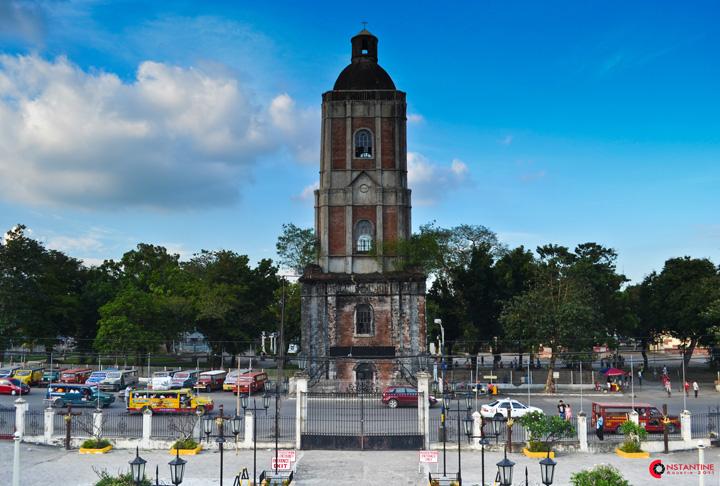
Jaro Belfry
Jaro is one of the six districts of Iloilo City, in the province of Iloilo, on the island of Panay, in the Western Visayas region of the Philippines. It is a former separate city that lends its name fot the Archdiocese of Jaro, which covers the provinces of Iloilo and Guimaras and is the Metropolitan of Western Visayas.
History
Its original name was Salog or Saro. It was also referred to as "Ilaya" or "mountain/dry land" together with La Paz which was referred to as "Ilawod" or "sea/wet land". It had been one of the richer areas of Iloilo City even during the Spanish colonial period (1521-1898) and probably the richest town of the entire colony. Historical artifacts indicate that it had once conducted trade with China and Siam (Thailand) due to its port along the navigable river that ran through the town. It was also the center of religious and economic power in the Visayas during the Spanish rule.
Jaro officially became a city in 1886. La Paz was a part of Jaro until it became independent from Jaro and became a town and incorporated into the city of Iloilo. It was later absorbed by the city of Iloilo along with the neighboring towns of Molo, Mandurriao, La Paz and Arevalo in the early 20th century when all economic activities were shifted to the port of Iloilo.
Jaro's celebration of the Feast of Nuestra Señora de la Candelaria (Our Lady of the Candles) every February 2 is well known in the Philippines. The district is notable for its large amount of nineteenth-century architecture. Straddling the main plaza is the antique Jaro Cathedral and the Palasyo, the Archbishop's residence.
The majority of the mestizo families from Iloilo came from this town because it was a center and main port during the Spanish period and many Spanish traders married natives and settled on the island.
Tourist attractions
- Jaro Belfry, ruined in a 1948 earthquake, but now restored. One of the few belfries in the country that stands apart from the church.
- Jaro Plaza, now called the Graciano Lopez Jaena Park, is the center of activity in Jaro and is surrounded by the Jaro Cathedral, the Jaro Belfry, several old mansions, the former Jaro City Hall and the Archbishop’s Palace.
- Jaro Cathedral, The Jaro Cathedral (Church of St. Elizabeth of Hungary) was built in 1864, the year the district was named a diocese by Pope Pius the IX, by order of His Grace Mariano Cuartero, first bishop of Jaro. Destroyed in the quake of January 1948 and restored by order of His Excellency Jose Ma. Cuenco, first archbishop of Jaro in 1956. The cathedral’s style is basically Baroque, with the addition of Gothic elements over many renovations.This has been approved by the CBCP as the National Shrine of Our Lady of Candles.
- Archbishop's Palace, the residence of the Archbishop of Jaro. It is located southwest of the Jaro Cathedral and Southeast of the Jaro Plaza.
- St. Vincent Ferrer Seminary
- Nelly Garden, the Lopez Mansion, also known as Nelly Garden, is one of the landmarks of Iloilo and a much-desired wedding venue due to its elegant facade and garden surroundings.
- Casa Montinola y Sanson, the house is reminiscent of the Gaston house in Silay City, Negros Occidental.
- Lizares Mansion, it was once the mansion of the Lizares family but was now turned into a school, Angelicum School Iloilo.
- Central Philippine University, the 24-hectare campus of CPU was chosen and declared as a tourist site by the Iloilo City Council. It was founded by the pioneer Protestant (Baptist) missionary, Rev. William Orison Valentine on 1905.
Accessibility
Iloilo Province is located in Western Visayas and can be reached by plane, bus, ferry or roro (roll-on-roll-off) from Manila.
By Air:
There are direct flights to Iloilo International Airport and take around 50 minutes from Manila. Once there, one can ride a shuttle van or taxi going to Iloilo City.
List of airlines that have daily trips to Manila to Iloilo:
- Cebu Pacific
- Air Philippines
- Philippine Airlines
- Zest Air
By Sea:
From Manila Ports, the travel time going to Iloilo Domestic Port, located along General Hughes St., is about 20 hours.
By Land:
There are buses from Manila that have trips to Iloilo City. The bus uses the roro (roll-on-roll-off) services going to Iloilo. The bus terminals in Cubao and Pasay have buses with trips going to Iloilo.
When touring the province, taxis and jeepneys are available as a mode of transportation around the province.









